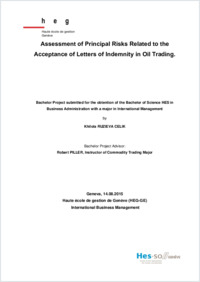Assessment of principal risks related to the acceptance of letters of indemnity in oil trading
SONAR|HES-SO
- Ruzieva Celik, Khilola
- Piller, Robert (Degree supervisor)
-
2015
71 p.
Mémoire de bachelor: Haute école de gestion de Genève, 2015
English
As oil became a globally traded product traders learnt to maximize their profits by moving energy commodities around the globe. Globalisation and technological development, besides having a durable positive effect on international maritime trade often triggers enormous risks. As much as financial institutions and big trading companies are trying to reconcile national differences between sourcing and consumption countries by minimising political risks, these transactions are never entirely risk free. Traders, ship-owners and bankers often ignore the implications that could stem from their engagements in profitable but not always straightforward obligations. Oil trading is very complex business. Usually, trading volumes are very high and require substantial financial resources and a strong logistic system that could manage potential risks. A chain of participants involved in execution of one sale contract includes numerous parties such as ship-owners, brokers, insurers, inspection specialists, port agents, financial institutions and experienced support staff. As a result, there are a number of risks that do not appear on the surface of transactions and arise as a consequence of negligence of contractual details or general misinterpretation. Often, these errors are caused due to mismatches between multiple contracts, Charterparties, letters of credits or, simply, a result of dishonest behaviour of partners. Traders do not work in ideal world where contract executions follow their exact mechanism, there are no last minute changes and documents always arrive on time to the discharge ports. That’s why the Letters of Indemnity are a great instrument that can remove a lot of barriers on the way of the traders. They facilitate timely delivery of cargoes to their receivers, reduce operational costs and as result, increase profit margins of traders. Hence, a Letter of Indemnity creates liabilities that fall beyond the framework of the sale contract and beyond the standard insurance coverage for ship-owners. Often, Letters of Indemnity generate liabilities under parties who might not have had an original unilateral contract. The biggest issues arise when the Letter of Indemnity is being called upon, and traders have to secure the claim of the carrier. Yet, they are used by traders on every day basis as market dynamics imposes its own rules on the entire industry.
- Language
-
- English
- Classification
- Economics
- Notes
-
- Haute école de gestion Genève
- Economie d'entreprise
- hesso:hegge
- License
-
License undefined
- Identifiers
-
- RERO DOC 258753
- RERO R008357828
- Persistent URL
- https://folia.unifr.ch/global/documents/314511
Statistics
Document views: 89
File downloads:
- Texte intégral: 365
